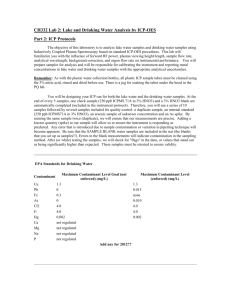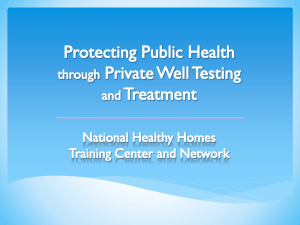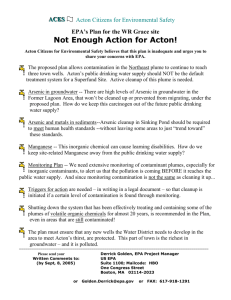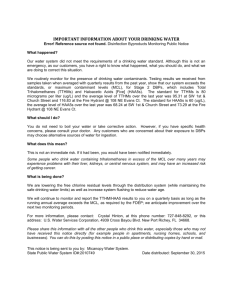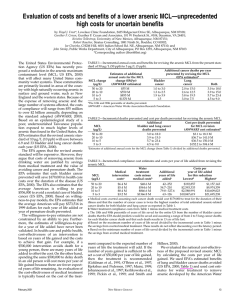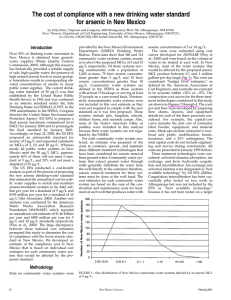The regulatory history of arsenic in drink-
advertisement
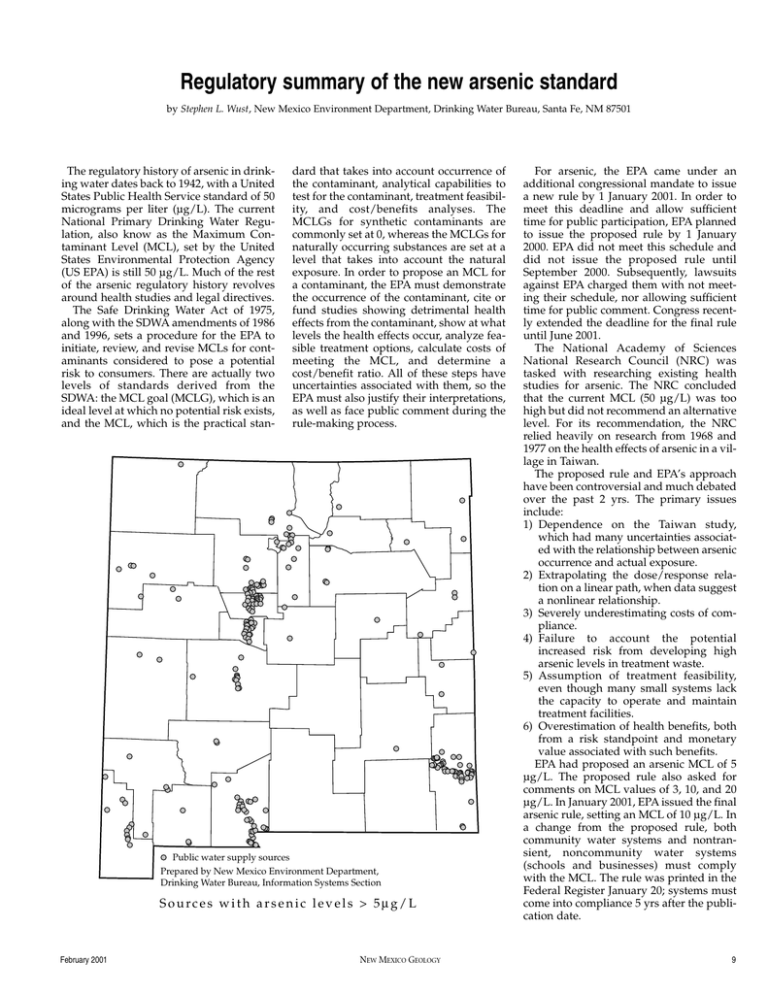
Regulatory summary of the new arsenic standard by Stephen L. Wust, New Mexico Environment Department, Drinking Water Bureau, Santa Fe, NM 87501 The regulatory history of arsenic in drinking water dates back to 1942, with a United States Public Health Service standard of 50 micrograms per liter (µg/L). The current National Primary Drinking Water Regulation, also know as the Maximum Contaminant Level (MCL), set by the United States Environmental Protection Agency (US EPA) is still 50 µg/L. Much of the rest of the arsenic regulatory history revolves around health studies and legal directives. The Safe Drinking Water Act of 1975, along with the SDWA amendments of 1986 and 1996, sets a procedure for the EPA to initiate, review, and revise MCLs for contaminants considered to pose a potential risk to consumers. There are actually two levels of standards derived from the SDWA: the MCL goal (MCLG), which is an ideal level at which no potential risk exists, and the MCL, which is the practical stan- dard that takes into account occurrence of the contaminant, analytical capabilities to test for the contaminant, treatment feasibility, and cost/benefits analyses. The MCLGs for synthetic contaminants are commonly set at 0, whereas the MCLGs for naturally occurring substances are set at a level that takes into account the natural exposure. In order to propose an MCL for a contaminant, the EPA must demonstrate the occurrence of the contaminant, cite or fund studies showing detrimental health effects from the contaminant, show at what levels the health effects occur, analyze feasible treatment options, calculate costs of meeting the MCL, and determine a cost/benefit ratio. All of these steps have uncertainties associated with them, so the EPA must also justify their interpretations, as well as face public comment during the rule-making process. Public water supply sources Prepared by New Mexico Environment Department, Drinking Water Bureau, Information Systems Section Sources with arsenic levels > 5µg/L February 2001 NEW MEXICO GEOLOGY For arsenic, the EPA came under an additional congressional mandate to issue a new rule by 1 January 2001. In order to meet this deadline and allow sufficient time for public participation, EPA planned to issue the proposed rule by 1 January 2000. EPA did not meet this schedule and did not issue the proposed rule until September 2000. Subsequently, lawsuits against EPA charged them with not meeting their schedule, nor allowing sufficient time for public comment. Congress recently extended the deadline for the final rule until June 2001. The National Academy of Sciences National Research Council (NRC) was tasked with researching existing health studies for arsenic. The NRC concluded that the current MCL (50 µg/L) was too high but did not recommend an alternative level. For its recommendation, the NRC relied heavily on research from 1968 and 1977 on the health effects of arsenic in a village in Taiwan. The proposed rule and EPA’s approach have been controversial and much debated over the past 2 yrs. The primary issues include: 1) Dependence on the Taiwan study, which had many uncertainties associated with the relationship between arsenic occurrence and actual exposure. 2) Extrapolating the dose/response relation on a linear path, when data suggest a nonlinear relationship. 3) Severely underestimating costs of compliance. 4) Failure to account the potential increased risk from developing high arsenic levels in treatment waste. 5) Assumption of treatment feasibility, even though many small systems lack the capacity to operate and maintain treatment facilities. 6) Overestimation of health benefits, both from a risk standpoint and monetary value associated with such benefits. EPA had proposed an arsenic MCL of 5 µg/L. The proposed rule also asked for comments on MCL values of 3, 10, and 20 µg/L. In January 2001, EPA issued the final arsenic rule, setting an MCL of 10 µg/L. In a change from the proposed rule, both community water systems and nontransient, noncommunity water systems (schools and businesses) must comply with the MCL. The rule was printed in the Federal Register January 20; systems must come into compliance 5 yrs after the publication date. 9

